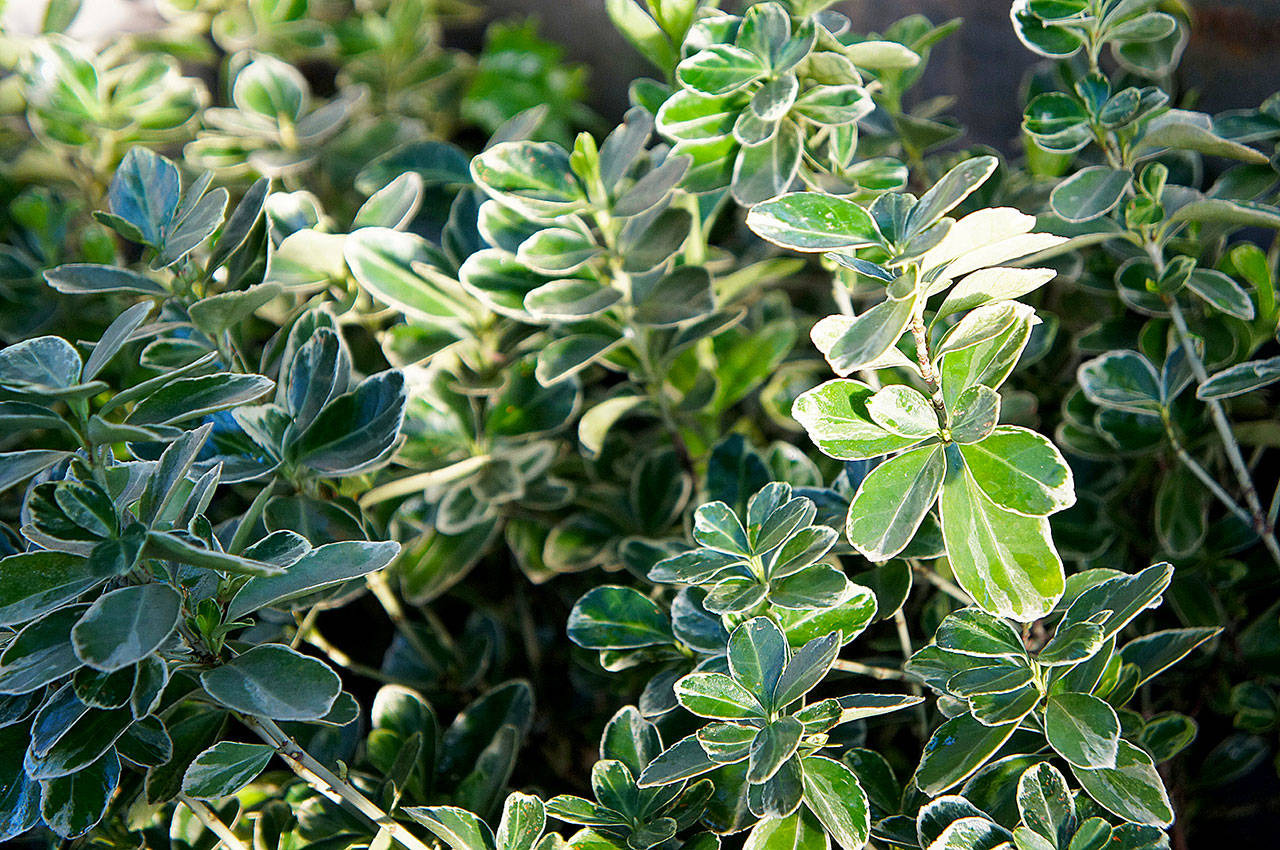We are fortunate, in our maritime climate, to be able to enjoy a wide selection of broadleaf evergreen shrubs — some of which will actually grow into small trees.
Rhododendrons, azaleas, hollies, Osmanthus, boxleaf honeysuckle, boxwood, fatsia, Leucothoe, laurels, privets, Pyracantha, and Viburnum davidii are just a few examples of the many options we have for shiny green foliage that can be used in our landscapes.
The genus Euonymus, with several available species, is one of my favorites and yet another option that gives us a variety of choices in foliage size, color and growth habit. These are very attractive, reliable and versatile plants that tend to be underutilized in the landscape.
Euonymus japonica is a nice shrub with glossy, 1-inch round leaves that can be found in many commercial settings due to its ease of growing, tolerance of a range of soils and sunlight conditions. Varieties like “Silver King,” “Silver Queen” and “Chollipo,” with their bright green and white variegated foliage, are commonly found. “Paloma Blanca” is a compact variety with smaller leaves that are almost pure white when they first emerge, and “Green Spire,” which sports a tight, upright growth habit is perfect for that narrow 1-foot-wide bed.
Euonymus fortunei, on the other hand, has a completely different growth habit that allows it to be used as a ground cover, hedge or even a vine. The common name for this species is climbing euonymus because of its tendency to climb up trees or walls if left on its own. In our landscapes, Euonymus fortunei is mostly used as a small shrub that is sheared into hedge form.
If you have noticed masses of bright-yellow foliage this past month in gardens in your neighborhood, chances are that they were a selection of Euonymus fortunei called “Emerald ‘N Gold” — sometimes labeled simply “Gold Mound.” “Emerald Gaiety” is a green-and-white form of this same plant.
Both varieties have a wild growth habit that can feel and look a bit unruly if left to their own devices, but like I said earlier, most gardeners end up shearing them to keep them in check. You can keep them down to under a foot tall for front-of-the-border uses or shape them into 2-by-2 foot rectangular hedges for a more formal look. I prefer the softer look and like to shape them into mushrooms. To each his own, I suppose.
For a real unusual look, you need to give “Wolong Ghost” a try. Also known as silver-veined wintercreeper, this dark green-leafed variety has silvery white veins that make a striking effect when in a hanging basket, but it is also well suited as a ground cover where it will hug the ground and crawl over rocks.
On my chimney on the north side of my house, I have a small leafed-variety (½ inch by ¼ inch) called “Kewensis” that is one of my favorites. It has covered my entire brick chimney up to 8 feet high and would continue all the way to the top if I let it. Giving the edges a quick trim in spring is all I have to do to control it — a breeze compared to something like ivy.
All fortunei varieties will grow in sun or shade and will take on a nice pinkish-purple tone in the winter, especially if they are planted in full sun. Shear them into a hedge, train them as a ground cover, or let them clamber up a tree trunk or masonry wall. Either way, you won’t be disappointed with the many flavors of evergreen Euonymus. Stay safe and keep on gardening.
Steve Smith is the owner of Sunnyside Nursery in Marysville and can be reached at sunnysidenursery@msn.com.
Two free classes
Sunnyside Nursery’s free gardening classes are online for now. An “All Things Hydrangeas” class is scheduled for 10 a.m. May 29, followed by a “Stop and Smell the Roses” class at 11 a.m. May 30 via Zoom. With registration, you’ll receive a Zoom link to attend the online class. For more information or to sign up, visit www.sunnysidenursery.net/classes.
Talk to us
> Give us your news tips.
> Send us a letter to the editor.
> More Herald contact information.

























